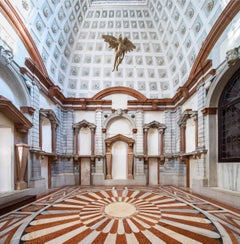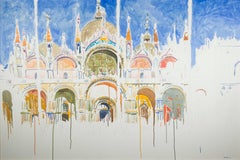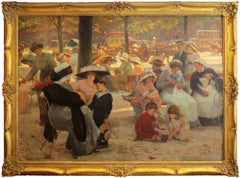Venetian
to
2
1
2
1
3
Overall Height
to
Overall Width
to
1
3
2
2
2
1
1
3
2
1
2
2
2
1
1
Laocoon II, Grimani Palace, Venice
By Reinhard Görner
Located in Los Angeles, CA
40 x 60 inches
ed. of 25
$6,000
50 x 75 inches
ed. of 15
$9,000
60 x 90 inches
ed. of 10
$11,000
signed and numbered on label, verso
Reinhard Görner, with his large format photog...
Category
21st Century and Contemporary Conceptual Venetian
Materials
Lambda
Ganymed, Palazzo Grimani, Venice
By Reinhard Görner
Located in Los Angeles, CA
50 x 49 inches
ed of 10
$6,000
60 x 59 inches
ed of 7
$9,000
70 x 68.8 inches
ed of 5
$11,000
signed and numbered on label, verso
Reinhard Görner with his large format photographs orchestrates the monumentality of rooms.
An active architecture photographer since 1985, is a master of perspectives and precise spatial compositions, and he thus considers classical sculpture, in all of its possible facets, a special challenge.
"Görner’s photographs sometimes open the doors to another world and take the viewer with them on a journey through time. Here the palace is no longer a museum but both royal residence and a site steeped in history. The viewer does not have to share the halls with the masses of visitors; instead the images offer him exclusive impressions of the Galerie des Glaces (Hall of Mirrors) and the Galerie des Batailles (Hall of Battles) as even the king of France was probably never granted. The halls are empty of people, yet they seem to be able to unfurl their individual characters of their own accord. These places practically breathe history, and this aspect is also part of the essence captured in the photographs. King Wilhelm of Prussia was named German Emperor Wilhelm I in the Hall of Mirrors after France was defeated in 1870–1871 in the Franco-German War. The Treaty of Versailles following World War I was also signed there in 1919. In this sense, the architectural photographs of Versailles...
Category
21st Century and Contemporary Conceptual Venetian
Materials
C Print, Lambda
Exterior of the Basilica, Venice, Italy
By Adam Van Doren
Located in Boston, MA
Adam Van Doren, American (b. 1962), Exterior of the Basilica, 2009. Signed lower right: "Van Doren". Painting dimensions: 40 x 60 inches. Framed dimensions: 40 3/4 x 60 3/4...
Category
21st Century and Contemporary Impressionist Venetian
Materials
Oil
Related Items
"Sunday in the Park, 1910"
By Cyprien Eugène Boulet
Located in Lambertville, NJ
Signed Lower Right
Cyprien-Eugène Boulet (1877 - 1927)
Category
Early 20th Century Impressionist Venetian
Materials
Canvas, Oil
Miner Hillard Milling Company
By George William Sotter
Located in New York, NY
Signed lower right: G.W. Sotter; on verso: MINER HILLARD / MILLING Co.
Category
Mid-20th Century American Impressionist Venetian
Materials
Oil, Board
Union Square, Winter (Washington Monument)
By Theodore Robinson
Located in New York, NY
As one of the first, and most important, American Impressionists, Theodore Robinson helped to introduce the French style to American artists and audiences.
Category
19th Century American Impressionist Venetian
Materials
Oil
Afternoon at the Beach
By Frederick Carl Frieseke
Located in Palm Desert, CA
A painting by Frederick Carl Frieseke. "Afternoon at the Beach" is a large scale, oil on canvas painting of a beach scene, depicting beach goers...
Category
20th Century American Impressionist Venetian
Materials
Canvas, Oil
Vue prise des Collettes, Cagnes by Pierre-Auguste Renoir - Landscape painting
By Pierre-Auguste Renoir
Located in London, GB
Vue prise des Collettes, Cagnes by Pierre-Auguste Renoir (1841-1919)
Oil on canvas
28 x 45.7 cm (11 x 18 inches)
Signed lower left, Renoir
Executed circa 1910-1911
This work is accompanied by a letter of authenticity from the Wildenstein Institute confirming its inclusion in the forthcoming catalogue raisonné of Pierre-Auguste Renoir being prepared by the Wildenstein Institute established from the archives of François Daulte, Durand-Ruel, Venturi, Vollard and Wildenstein.
Provenance: Mme Chavan, Lausanne
Sotheby’s London, 2nd December 1981
Sotheby’s London, 4th February 2004
Richard Green, London
Private collection, acquired from the above in August 2004
Stern Pissarro Gallery, London
Private collection, London, acquired from the above
Literature: A.Vollard, Pierre-Auguste Renoir, Tableaux, pastels et dessins, Paris, 1918
G-P. Dauberville and M. Dauberville, Renoir: Catalogue raisonné des tableaux, pastels, dessins et aquarelles, 1903-1910, vol 4, no. 2930
Artist biography:Renoir began his artistic career as a porcelain painter but began copying paintings...
Category
1910s Impressionist Venetian
Materials
Canvas, Oil
Free Shipping
H 11.03 in W 18 in
Deep Inside III #11 by Jaume Llorens - Seascape Photography, Nature Photography
Located in Brighton, GB
Born in Porqueres, a small village in Catalonia, Llorens has lived by the lake Banyoles his entire life. Inspired by this unique body of water, Llorens’ photographs describe a unique...
Category
2010s Contemporary Venetian
Materials
Giclée
H 11.82 in W 17.72 in D 0.04 in
"In Port"
By Edward Willis Redfield
Located in Lambertville, NJ
Jim’s of Lambertville is proud to offer this artwork by:
Edward Willis Redfield (1869 - 1965)
Edward W. Redfield was born in Bridgeville, Delaware, moving to Philadelphia as a young child. Determined to be an artist from an early age, he studied at the Spring Garden Institute and the Franklin Institute before entering the Pennsylvania Academy from 1887 to 1889, where he studied under Thomas Anshutz, James Kelly, and Thomas Hovenden. Along with his friend and fellow artist, Robert Henri, he traveled abroad in 1889 and studied at the Academie Julian in Paris under William Bouguereau and Tony Robert-Fleury. While in France, Redfield met Elise Deligant, the daughter of an innkeeper, and married in London in 1893.
Upon his return to the United States, Redfield and his wife settled in Glenside, Pennsylvania. He remained there until 1898, at which time he moved his family to Center Bridge, a town several miles north of New Hope along the Delaware River. Redfield painted prolifically in the 1890s but it was not until the beginning of the twentieth century that he would develop the bold impressionist style that defined his career. As Redfield’s international reputation spread, many young artists gravitated to New Hope as he was a great inspiration and an iconic role model. Edward Redfield remained in Center Bridge throughout his long life, fathering his six children there.
Around 1905 and 1906, Redfield’s style was coming into its own, employing thick vigorous brush strokes tightly woven and layered with a multitude of colors. These large plein-air canvases define the essence of Pennsylvania Impressionism. By 1907, Redfield had perfected his craft and, from this point forward, was creating some of his finest work.
Redfield would once again return to France where he painted a small but important body of work between 1907 and 1908. While there, he received an Honorable Mention from the Paris Salon for one of these canvases. In 1910 he was awarded a Gold Medal at the prestigious Buenos Aires Exposition and at the Panama-Pacific Exposition of 1915 in San Francisco, an entire gallery was dedicated for twenty-one of his paintings.
Since Redfield painted for Exhibition with the intent to win medals, his best effort often went into his larger paintings. Although he also painted many fine smaller pictures, virtually all of his works were of major award-winning canvas sizes of 38x50 or 50x56 inches. If one were to assign a period of Redfield’s work that was representative of his “best period”, it would have to be from 1907 to 1925. Although he was capable of creating masterpieces though the late 1940s, his style fully matured by 1907 and most work from then through the early twenties was of consistently high quality. In the later 1920s and through the 1930s and 1940s, he was like most other great artists, creating some paintings that were superb examples and others that were of more ordinary quality.
Redfield earned an international reputation at a young age, known for accurately recording nature with his canvases and painting virtually all of his work outdoors; Redfield was one of a rare breed. He was regarded as the pioneer of impressionist winter landscape painting in America, having few if any equals. Redfield spent summers in Maine, first at Boothbay Harbor and beginning in the 1920s, on Monhegan Island. There he painted colorful marine and coastal scenes as well as the island’s landscape and fishing shacks. He remained active painting and making Windsor style furniture...
Category
Early 1900s American Impressionist Venetian
Materials
Canvas, Oil
"Forest Strongholds"
By John F. Carlson
Located in Lambertville, NJ
Signed lower right. Complemented by a hand carved and gilt frame.
Exhibited at the National Academy of Design, 1928
Category
20th Century American Impressionist Venetian
Materials
Canvas, Oil
Winter Moonlight
By George William Sotter
Located in Lambertville, NJ
signed lower right
Category
1910s American Impressionist Venetian
Materials
Canvas, Oil
"Late Afternoon at Brighton Beach"
By Martha Walter
Located in Lambertville, NJ
Jim’s of Lambertville Fine Art Gallery is proud to present this piece by Martha Walter (1875 - 1976).
Born in Philadelphia in 1875, Martha Walter attended Girls’ High School followe...
Category
1910s American Impressionist Venetian
Materials
Canvas, Oil
"The Canal"
By Edward Willis Redfield
Located in Lambertville, NJ
Jim’s of Lambertville is proud to offer this artwork.
Signed lower left. Complemented by a hand carved and gilt frame.
Illustrated in "Edward Redfield: Just Values and Fine Seeing" by Constance Kimmerle and the Pennsylvania Academy of the Fine Arts's Exhibition of Paintings by Edward Redfield (April 17 to May 16, 1909) brochure
Edward Willis Redfield (1869 - 1965)
Edward W. Redfield was born in Bridgeville, Delaware, moving to Philadelphia as a young child. Determined to be an artist from an early age, he studied at the Spring Garden Institute and the Franklin Institute before entering the Pennsylvania Academy from 1887 to 1889, where he studied under Thomas Anshutz, James Kelly, and Thomas Hovenden. Along with his friend and fellow artist, Robert Henri, he traveled abroad in 1889 and studied at the Academie Julian in Paris under William Bouguereau and Tony Robert-Fleury. While in France, Redfield met Elise Deligant, the daughter of an innkeeper, and married in London in 1893.
Upon his return to the United States, Redfield and his wife settled in Glenside, Pennsylvania. He remained there until 1898, at which time he moved his family to Center Bridge, a town several miles north of New Hope along the Delaware River. Redfield painted prolifically in the 1890s but it was not until the beginning of the twentieth century that he would develop the bold impressionist style that defined his career. As Redfield’s international reputation spread, many young artists gravitated to New Hope as he was a great inspiration and an iconic role model. Edward Redfield remained in Center Bridge throughout his long life, fathering his six children there.
Around 1905 and 1906, Redfield’s style was coming into its own, employing thick vigorous brush strokes tightly woven and layered with a multitude of colors. These large plein-air canvases define the essence of Pennsylvania Impressionism. By 1907, Redfield had perfected his craft and, from this point forward, was creating some of his finest work.
Redfield would once again return to France where he painted a small but important body of work between 1907 and 1908. While there, he received an Honorable Mention from the Paris Salon for one of these canvases. In 1910 he was awarded a Gold Medal at the prestigious Buenos Aires Exposition and at the Panama-Pacific Exposition of 1915 in San Francisco, an entire gallery was dedicated for twenty-one of his paintings.
Since Redfield painted for Exhibition with the intent to win medals, his best effort often went into his larger paintings. Although he also painted many fine smaller pictures, virtually all of his works were of major award-winning canvas sizes of 38x50 or 50x56 inches. If one were to assign a period of Redfield’s work that was representative of his “best period”, it would have to be from 1907 to 1925. Although he was capable of creating masterpieces though the late 1940s, his style fully matured by 1907 and most work from then through the early twenties was of consistently high quality. In the later 1920s and through the 1930s and 1940s, he was like most other great artists, creating some paintings that were superb examples and others that were of more ordinary quality.
Redfield earned an international reputation at a young age, known for accurately recording nature with his canvases and painting virtually all of his work outdoors; Redfield was one of a rare breed. He was regarded as the pioneer of impressionist winter landscape painting in America, having few if any equals. Redfield spent summers in Maine, first at Boothbay Harbor and beginning in the 1920s, on Monhegan Island. There he painted colorful marine and coastal scenes as well as the island’s landscape and fishing shacks. He remained active painting and making Windsor style furniture...
Category
Early 1900s American Impressionist Venetian
Materials
Canvas, Oil
"Le Dompteur de Pigeons" (ex. Christie's) - Large Antique Impressionist Painting
By Georges Jules Victor Clairin
Located in New Orleans, LA
A large, spectacular, absolutely splendid painting by noted French painter Georges Clairin, which appeared for auction at Christie's in 2004 (see photo...
Category
Late 19th Century Impressionist Venetian
Materials
Oil




